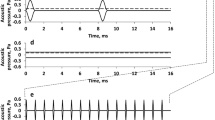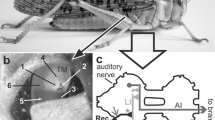Summary
The summating potential (SP) recorded from the scala tympani increased eight to ten-fold during spring (Fig. 1). The sensitivity of hearing as judged by the gross response components also increased in the same period (Figs. 2, 3). The overall effect, from an optimum in spring, was an oblique shift in the intensity curves of all gross response components to the poorer responses at other times of the year. Mechanisms explaining the seasonal changes, in terms of a change to the electrical tuning properties of cochlear hair cells, are evident in (1) the oblique shift in the intensity curves, (2) increased temperature sensitivity of the SP (Figs. 5, 6), (3) a change in the relationship between the fundamental and frequency doubling a.c. response with overall changes in sensitivity (Fig. 7), and (4) a significant association between increased hearing responsiveness and metabolic rate (Figs. 8, 9).
Similar content being viewed by others
Abbreviations
- CAP :
-
compound action potential
- CM :
-
cochlear microphonic
- CMF :
-
cochlear microphonic fundamental
- CMH :
-
cochlear microphonic second harmonic
- OCR :
-
oxygen consumption rate
- SP :
-
summating potential
References
Bennett AF, Dawson WR (1976) Metabolism. In: Gans C, Dawson WR (eds) Biology of the reptilia, vol 5. Academic Press, London New York, pp 127–223
Bourne AR, Seamark RF (1975) Seasonal changes in 17β-hydroxysteroids in the plasma of a male lizard (Tiliqua rugosa). Comp Biochem Physiol 50B:535–536
Bourne AR, Seamark RF (1978) Seasonal variation in steroid biosynthesis by the testis of the lizardTiliqua rugosa. Comp Biochem Physiol 59B:363–367
Bull CM (1978a) Dispersal of the Australian reptile tickAponomma hydrosauri by host movement. Aust J Zool 26:689–697
Bull CM (1978b) Heterogeneity of resource utilization in a population of the Australian reptile tickAponomma hydrosauri (Denny). Ecol Entomol 3:171–179
Bull CM, Satrawaha R (1980) Dispersal and social organization inTrachydosaurus rugosus. In: Banks CB, Martin AA (eds) Proceedings of the Melbourne Herpetological Symposium 1980. Zoological Board of Victoria, Melbourne, p 24
Campbell HW (1969) The effects of temperature on the auditory sensitivity of lizards. Physiol Zool 42:183–210
Eatock RA, Manley GA (1981) Auditory nerve fibre activity in the Tokay gecko. II. Temperature effects on tuning. J Comp Physiol 142:219–226
Fettiplace R, Crawford AC (1980) The origin of tuning in turtle cochlear hair cells. Hearing Res 2:447–454
Firth BT, Kennaway DJ (1980) Plasma melatonin levels in the scincid lizardTrachydosaurus rugosus: effect of lateral eye and parietal eye impairment. J Exp Biol 85:311–321
Firth BT, Kennaway DJ, Rozenbilds MAM (1979) Plasma melatonin in the scincid lizard,Trachydosaurus rugosus: diel rhythm, seasonality and effect of constant light and constant darkness. Gen Comp Endocrinol 37:493–500
Fuchs PA, Fettiplace R, Crawford AC, Art JJ (1983) Synaptic hyperpolarisation and loss of tuning in the turtle cochlear hair cells. In: Klinke R, Hartmann R (eds) Hearing — Physiological bases and psychophysics. Springer, Berlin Heidelberg New York Tokyo, pp 25–31
Guernsey DL, Edelman IS (1983) Regulation of thermogenesis by thyroid hormones. In: Oppenheimer JH, Samuels HH (eds) Molecular basis of thyroid hormone action. Academic Press, London New York, pp 293–324
Gutgesell VJ (1976) Seasonal variation in the anoxia sensitivity of the lizard saccule. Comp Bioch Physiol 54A:407–408
Haldar C, Thaphiyal JP (1977) Effect of pinealectomy on the annual testicular cycle ofCalotes versicolor. Gen Comp Endocrinol 32:395–399
Hemmingsen AM (1960) Energy metabolism as related to body size and respiratory surfaces, and its evolution. Rep Steno Mem Hosp Nord Insulin Lab 9:1–110
Heusner AA, Jameson EW (1981) Seasonal changes in oxygen consumption and body composition ofSceloporus occidentalis. Comp Biochem Physiol 69A:363–372
Hodgkin AL, Huxley AF (1952) A quantitative description of membrane current and its application to conductance and excitation in nerve. J Physiol 117:500–544
Holmes RM, Johnstone BM (1984) Gross potentials recorded from the cochlea of the skinkTiliqua rugosa. I. Characterization of evoked responses with regard to morphology. J Comp Physiol A 154:719–727
Holmes RM, Fergusson B, Johnstone BM (1984) Seasonal hydration changes in the skinkTiliqua rugosa. An effect on the evoked potentials recorded from the round window of the cochlea. Comp Biochem Physiol (in press)
Ismail-Beigi F, Edelman IS (1970) Mechanisms of thyroid calorigenesis: role of active sodium transport. Proc Natl Acad Sci USA 67:1071–1078
Johnstone JR, Johnstone BM (1969a) Electrophysiology of the lizard cochlea. Exp Neurol 24:99–109
Johnstone JR, Johnstone BM (1969b) Unit responses from the lizard auditory nerve. Exp Neurol 24:528–537
Levey IL (1973) Effects of pinealectomy and melatonin injections at different seasons in ovarian activity in the lizardAnolis carolinensis. J Exp Zool 185:169–174
Licht P (1965) Effects of temperature in heart rates of lizards during rest and activity. Physiol Zool 38:129–137
Licht P (1971) Regulation of the annual testis cycle by photoperiod and temperature in the lizardAnolis carolinensis. Ecology 52:240–252
Licht P, Dawson WR, Shoemaker VH, Main AR (1966) Observations on the thermal relations of Western Australian lizards. Copeia 1966:97–110
Mautz WJ, Case TJ (1974) A diurnal activity cycle in the granite night lizard,Xantusia henshawi. Copeia 1974:243–251
Mayhew WW (1965) Hibernation in the horned lizard,Phrynosoma m'calli. Comp Biochem Physiol 16:103–119
Moberly WR (1963) Hibernation on the desert iguana,Dipsosaurus dorsalis. Physiol Zool 26:152–160
Packard MJ, Packard GC (1977) Antigonadotrophic effect of melatonin in male lizards (Callisaurus draconoides). Experientia 33:1665–1666
Roberts LA (1968) Oxygen consumption in the lizardUta stansburiana. Ecology 49:809–819
Russell IJ, Ashmore JF (1983) Inner hair cell receptor potentials investigated during transient asphyxia: a model for hair cell coupling. In: Klinke R, Hartmann R (eds) Hearing-Physiological bases and psychophysics. Springer, Berlin Heidelberg New York Tokyo, pp 10–16
Russell IJ, Sellick PM (1981) Low-frequency characteristics of intracellularly recorded receptor potentials in guinea-pig cochlea hair cells. J Physiol 338:179–206
Satrawaha R, Bull CM (1981) The area occupied by an omnivorous lizard,Trachydosaurus rugosus. Aust Wildl Res 8:435–442
Schmidt RS, Fernandez C (1962) Labyrinthine d.c. potentials in representative vertebrates. J Cell Comp Physiol 59:311–322
Shield J (1966) Oxygen consumption during pouch development of the macropod marsupialSetonix brachyurus. J Physiol 187:257–270
Shoemaker VH, Licht P, Dawson WR (1966) The effects of temperature on kidney function in the lizardTiliqua rugosa. Physiol Zool 39:244–252
Stebbins RC, Cohen NW (1973) The effect of parietalectomy on the thyroid and gonads in free living western fence lizards,Sceloporus occidentalis. Copeia 1973:662–668
Underwood H (1979) Melatonin effects circadian rhythmicity in lizards. J Comp Physiol 130:317–327
Warburg MR (1965) The influence of ambient temperature and humidity on the body temperature and water loss from two Australian lizards,Tiliqua rugosa (Gray) (Scincidae) andAmphibolurus barbatus Cuvier (Agamidae). Aust J Zool 13:331–350
Weiss TF, Altmann DW, Mulroy MJ (1978) Endolymphatic and intracellular resting potential in the alligator lizard cochlea. Pflügers Arch 373:77–84
Werner YL (1972) Temperature effects on the inner-ear sensitivity in six species of iguanid lizards. J Herpetol 6:147–177
Werner YL (1976) Optimal temperatures for inner-ear performance in gekkonoid lizards. J Exp Zool 196:319–352
Werner YL (1983) Temperature effects on cochlear function in reptiles: a personal review incorporating new data. In: Fay RR, Gourevitch G (eds) Hearing and other senses: presentations in honour of EG Wever. Amphora Press Groton, USA pp 149–174
Wilson KJ (1974) The relationship of oxygen supply for activity to body temperature in four species of lizards. Copeia 1974:920–934
Author information
Authors and Affiliations
Rights and permissions
About this article
Cite this article
Holmes, R.M., Johnstone, B.M. Gross potentials recorded from the cochlea of the skinkTiliqua rugosa . J. Comp. Physiol. 154, 729–738 (1984). https://doi.org/10.1007/BF01350226
Received:
Issue Date:
DOI: https://doi.org/10.1007/BF01350226




